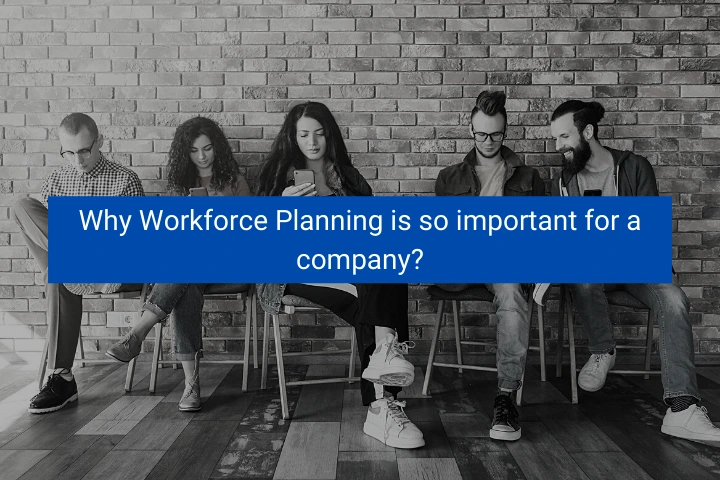Workforce planning can be the key to ensuring a bright future for you and your employees in any business or organization that employs people. In essence, workforce planning entails identifying and analyzing what your company needs in terms of workforce experience, knowledge, skills, and quality in order to meet its goals. Workforce planning is especially important during times of organizational transition, as it enables the company to adapt to change while also preparing for the difficulties ahead in a positive and proactive manner.

Understanding individual skills and talents, as well as working with them in such a way as to get the most out of them, is the first step towards making the most of your present personnel. Among the things you can do to properly manage your existing talent are -
- Providing flexible working hours, allowing employees to make the most of their work schedules and hours.
- Identifying skill shortages in your current staff and either providing training to departing employees or recruiting new personnel to fill such gaps.
- Determining which functions are outmoded and dispersing personnel accordingly.
- Providing flexible working hours, training and development, and a variety of additional employment benefits to ensure employee happiness.
Related: 5 Best Strategies of Workforce Planning
If you’re expanding, hiring more employees, moving to larger premises, or diversifying your business, an HR Administrator can provide a strategic overview and lead on a long-term plan for your company’s workforce development. They will be best positioned to help manage and develop your existing personnel, as well as attract the new talent you require to make your firm a success if they have a strategic long view.
Simple economics is one of the driving principles behind good and successful workforce planning. As a Human Resources Company we know that when workforce planning is done correctly, it may work to enhance productivity and lower your salary expense in real terms. When your employees are efficiently and strategically managed, your company will have the right people working in the right places at the right times, resulting in increased production.
Workforce planning is critical because it encourages everyone, from management to employees, to think about the future, both for themselves and for the company. It assists aspiring employees in moving forward, reorganizing people into roles that are more suited to them, and anticipating the future so that there are no surprises. It necessitates that managers and team leaders plan ahead of time and examine all business possibilities. Effective workforce planning is, in essence, an integrated talent management system that can aid in the development and growth of your company, always looking ahead and anticipating the next step.
Related: Difference Between Talent Acquisition and Talent Management
The workforce analysis, competency tests, gap analysis, and workforce transition planning that make up the planning process must all be documented in a workforce plan. These data serve as documentation for the inputs and are the planning’s primary output. This data proves the validity of any workforce plan by demonstrating the connections between workforce planning and program management, budget justifications, organizational goals, and human resource work planning.
Workforce planning gives managers a strategic foundation for making human resource management decisions that are aligned with program objectives. Forecasting models based on workforce analysis enable managers to anticipate turnover and plan recruiting and employee development in order to move toward the workforce required in the future, forming a radar for continuous monitoring.
Workload planning for human resources offices includes plans for workforce transition, indicating activity levels for internal training, movement, reassignment, and recruiting. This enables human resources managers to better organize workloads and activities, as well as better service management. To make this relationship work, human resources offices must train their employees in a wide range of human resources capabilities, including workforce analysis and strategy planning.
Related: Human Resource – Performance Management System and KPIs
The 6 key steps of Workforce Planning
Supply Analysis
Determining organizational competencies, examining staff demographics, and identifying hiring patterns are all part of supply analysis. Competency analysis establishes a baseline for the current organization and personnel. In the absence of management action, trend analysis gives both descriptive and forecasting models outlining how turnover will affect the workforce. The solution analysis phase requires trend analysis.
Demand Analysis
Demand analysis is concerned with estimating future activities and workloads, as well as identifying the skill set required of the future workforce. Not only must demand analysis account for workforce changes caused by changing work, but also for workforce changes caused by changing workload and work processes. Technology will continue to have an impact on how people work, and this must be taken into account during the demand analysis process.
Gap Analysis
Gap analysis is the act of evaluating data from supply and demand analyses to find disparities — or gaps — between present organizational competencies and the competency set required in the future workforce. The competency sets produced in the supply and demand analysis phases must be comparable, not independently developed, for the comparison to work. Gap analysis finds circumstances where the present workforce’s personnel or competencies will not meet future demands (demand exceeds supply) and situations where the current workforce’s individuals or competencies will exceed future needs (supply exceeds demand).
Solution Analysis
The process of identifying solutions for correcting gaps in competencies and reducing surplus competencies is known as solution analysis. In solution analysis, a variety of strategies are available, including planned recruiting, training, re-training, and employee placement. The direction of anticipated workforce change must be considered in the solution analysis, as well as recruitment trends that may operate in favor of or against it.
Workforce Skills Analysis
A workforce skills analysis is a procedure that identifies the skills needed to do a task. Conducting a workforce skills analysis necessitates an organization’s leaders anticipating how the nature of their work will change in the future and then identifying future human resource requirements. (This approach encompasses both the supply and demand sides of workforce planning.)
Job Analysis
Job analysis is the process of gathering information on good job performance. Tasks, responsibilities, knowledge and skill requirements, and other characteristics that contribute to successful work performance are the focus of job analysis. In this method, information gathered from employees is used to identify competencies.
Related: Define Risk Analysis in Human Resource Department
Considerations of a functional nature Support and leadership from management
Workforce planning is a method of aligning organizational and program aims with the financial and human resources required to achieve them. Managers and their organizations can design workforce plans to assist them to achieve their strategic objectives by starting the planning process with specified strategic objectives.
At the same time, because there is a clear link between objectives and the budget and human resources required to achieve them, these plans provide a solid foundation for supporting budget and staffing requests.
Top management commitment and leadership are required for workforce planning to be successful. Senior-level managers are responsible for leading the planning process, ensuring that workforce plans are aligned with strategic goals, and holding subordinate managers accountable for implementing workforce planning and using its products.
Similarly, program managers must lead the personnel planning process in their respective program areas and offices. The most immediate benefits of workforce planning will accrue to program managers since their own staff’s competencies will be better matched with strategic goals and directions.
Related: Challenges to setting up an HR Department in a start-up
Evaluation / feedback / adjustments
We pointed out that evaluation and revisions are a part of every planning process, including workforce planning. Any workforce transformation strategy developed by managers and project leaders must include an assessment methodology. Managers must assess not only if projected workforce changes are occurring, but also the assumptions that the transition strategy is built on. Both internal program management and external influences have an impact on strategic direction.
Planning timeframe
When it comes to workforce planning, companies must evaluate how far into the future they want to predict. Managers must strike a balance between the certainty of short-term planning and the necessity to plan for longer-term goals.
For Human Resource, Payroll and many more HR Services, visit our website https://lingueeglobal.com/



